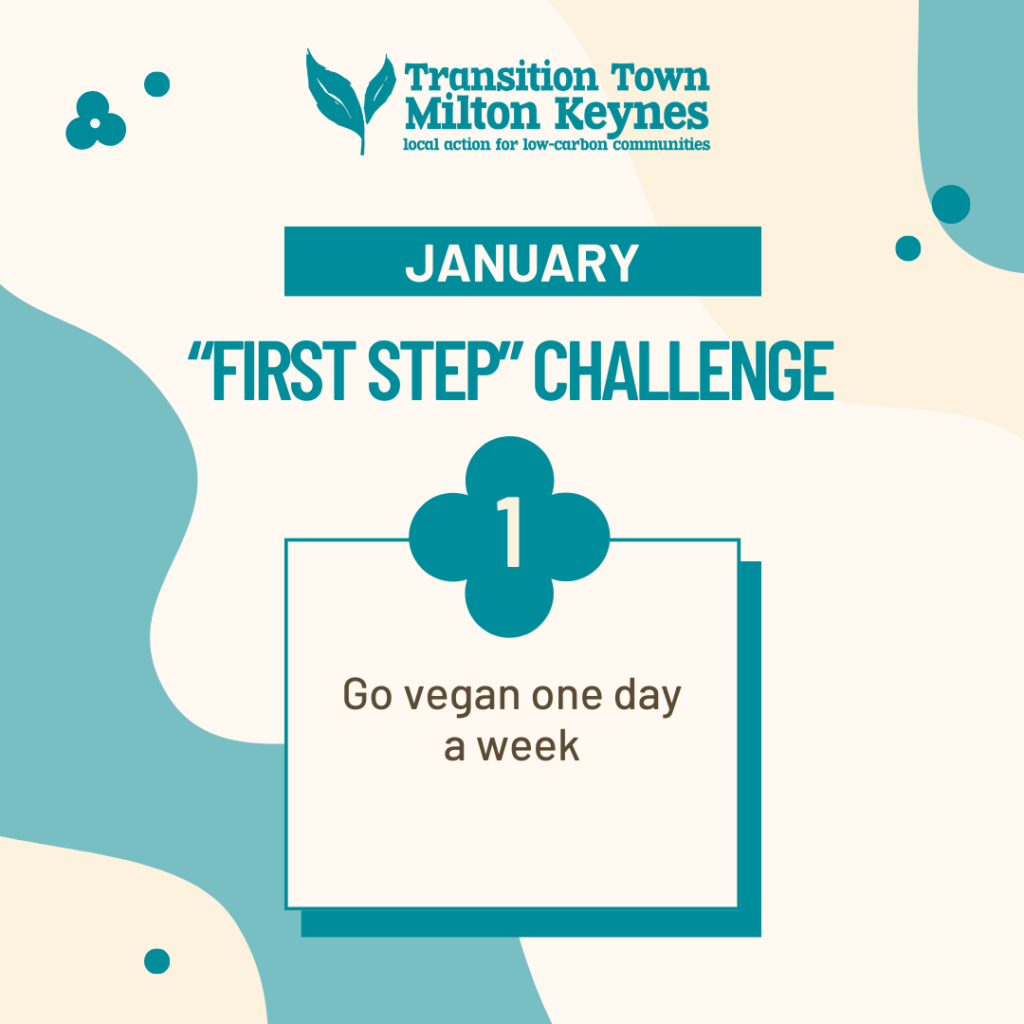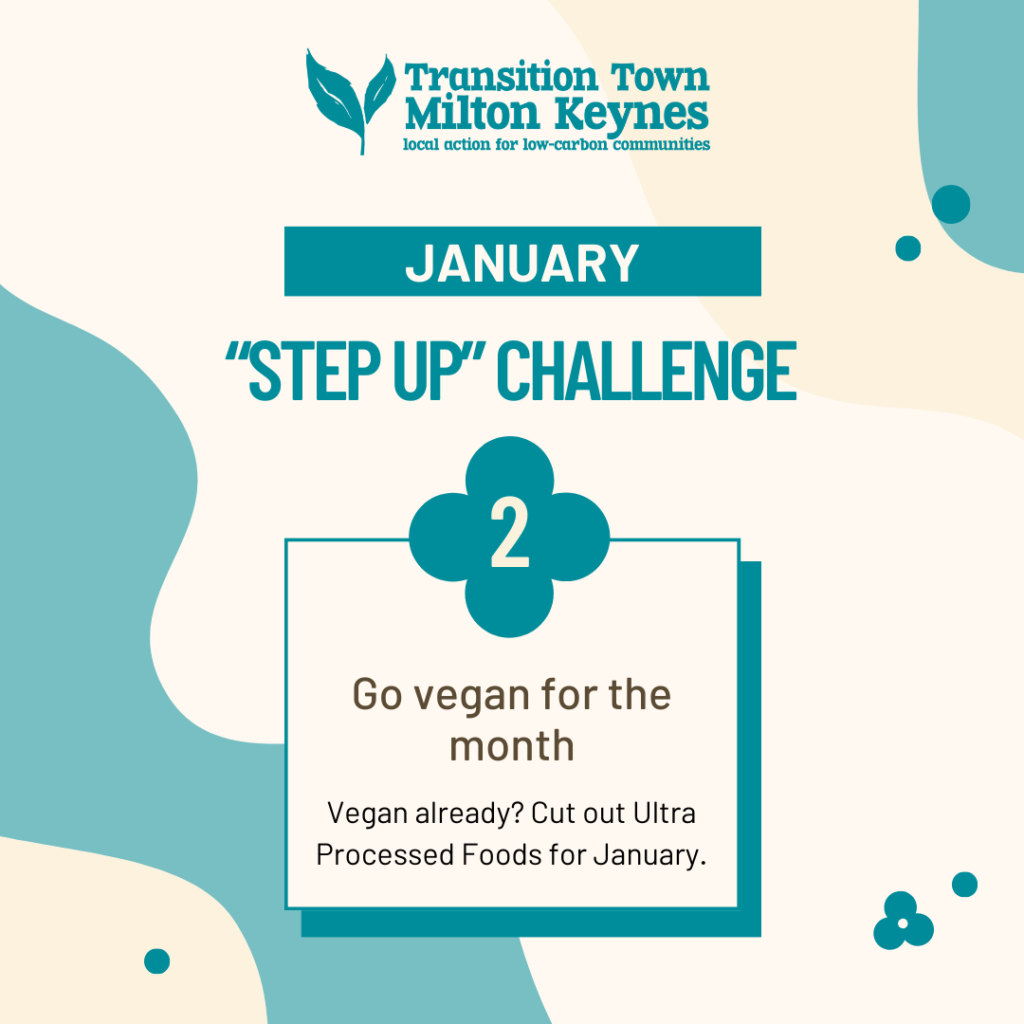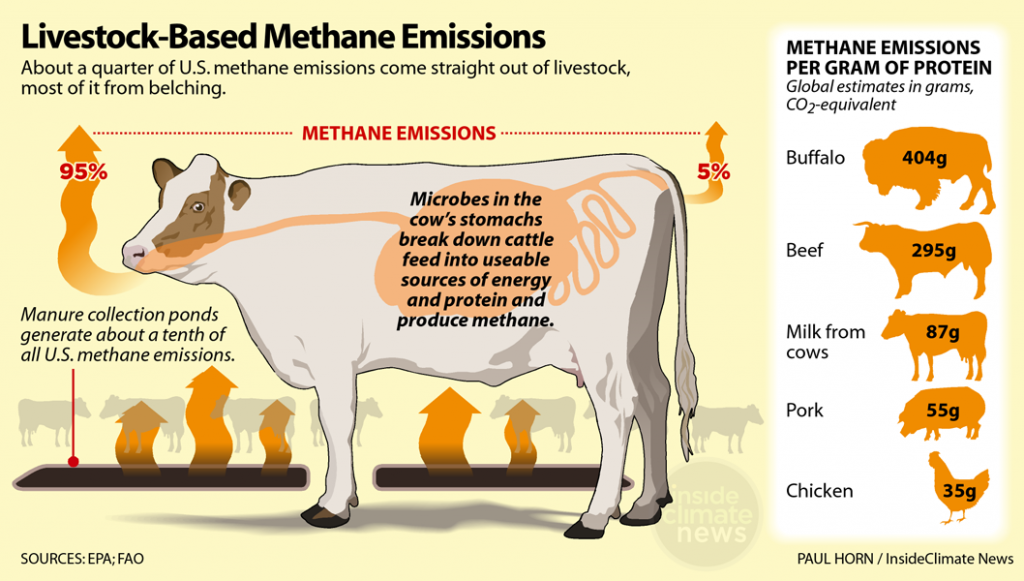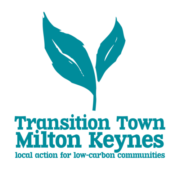January 2024 “Eat4Change”
Eco-Challenge
Our challenge for this month is to reduce our meat and dairy consumption.
If you typically eat a lot of meat and dairy every week, then try our
“First Step” Challenge:
Go vegan one day a week

Tailor it to challenge yourself: If you can commit to eating vegan meals for more than one day a week, then increase the challenge, or consider adding some vegetarian meal days in the mix too.
If you already have a largely vegetarian and/or vegan diet, then try our
“Step Up” Challenge:
Go vegan for the month

Tailor it to challenge yourself: If you have already replaced meat and dairy in your diet with plant-based alternatives, consider swapping out Ultra-Processed Foods for healthier options.
What to do next
1. Start planning for your challenge now.
It’s worth planning ahead for how you’re going to tackle your Eat4Change eco-challenge in January. It’s useful to create a weekly food plan so that you can shop for the items you need ahead of time and have recipes ready to go when you need them.
2. Attend our Social Evening to discover more about this topic and to discuss this month’s eco-challenge with other challengers.
Our guest speaker promises you lots of useful recipes and practical tips to help you with you eco-challenge to reduce your meat and dairy consumption in January. The event will take place at Aiimi in central Milton Keynes on Wednesday 10 January from 6.30pm – 8pm. Click here to register via EventBrite.
3. Share your tips, experiences and insights with other people doing this eco-challenge on our group Padlet.
(Simply click the image below to access the Padlet, then click the plus icon at bottom right to begin a post.)

4. Gain more understanding about how your food choices impact the planet by calculating your foodprint. Try one of these foodprint calculators that Earthday.org recommends:
BBC Climate Change Food Calculator shows how your food intake compares to emissions of driving, heating a home and consuming water.
Eat Lower Carbon compares the carbon foodprint of different meals, and tests your knowledge on common foods.
Food Carbon Emissions Calculator provides a comprehensive approach to calculating your foodprint. It accounts for transport, waste, and quantity purchased.
Our partner FoodPrint has a fun and easy quiz that helps you better understand the concept of a foodprint and shows you how well you’re doing so far.
How Does Your Diet Contribute to Climate Change? The New York Times quiz allows you to choose common meals and beverages to see how your carbon foodprint compares to others.
The Meat Calculator shows you how much water and carbon dioxide you save if reducing your meat consumption. It also tells you the approximate number of animals that could live from your reduction.
Why this eco-challenge is important
According to “52 Climate Actions”, eating less meat and dairy is one of the most powerful actions you can take to reduce your climate impact. This is because meat and dairy have a very high carbon footprint, particularly when it comes to beef and lamb.
The Environmental Working Group have calculated the carbon footprint of one KG of many everyday foods in the U.S. As you can see from the table below, the huge emissions for every kg of lamb, beef, cheese, and chicken make it clear to see why 10-15% of global climate changing gases are from meat and dairy production.
The Greenhouse Gas Emissions of Everyday Foods: Kg CO2e per Kg of food
| Lamb | 39.2 |
| Beef | 27 |
| Cheese | 13.5 |
| Chicken | 6.9 |
| Potatoes | 2.9 |
| Yoghurt | 2.2 |
| Lentils | 0.9 |
Why beef, lamb, and cheese are so bad for climate change
Sheep and cows are ruminant animals, which means they have specialised stomachs that allow them to eat grass. A by-product of this digestion process is that they release methane, a greenhouse gas 20 times stronger than CO2.

There have always been ruminant animals – from North America’s bison to Europe’s wild sheep and goats. So it’s perfectly possible to include farmed ruminants in climate-friendly agriculture. The problem is that the number of ruminants around the globe is rapidly increasing and typically, outside of the UK*, most of them are no longer fed on grass but on corn, soya, or wheat.
Feeding animals on crops like these, that humans can eat, is a very inefficient way of producing food. So on the one hand it’s OK to have a little grass-fed beef, lamb, and dairy in your diet, but on the other hand eating these foods in large quantities is a real problem. If you do eat beef, lamb, and dairy, source it well and as locally as possible.
So, a climate friendly diet has three key steps:
- Minimise consumption of beef and lamb and source it carefully
- Make a well thought through ethical choice about being vegan, vegetarian or omnivore
- Reduce the amount of food you waste, especially meat
*In the UK, most cattle are required to be grass-fed at least some of the time – Pasture for Life guarantees all its meat is from 100% grass fed animals.
Is vegan always better?
A vegan diet is better for the climate, and has strong ethical and health reasons as a choice of diet too. When rainforest is cut down to grow soya, it’s mainly for feeding to cows, not humans. However, some vegan foods have a high carbon footprint, such as out of season tomatoes and air freighted asparagus, so avoid them.
Being vegan isn’t healthy for everyone though; if you’re a nursing mother or have an underlying health condition or anaemia, read around the subject first. If you live in a very cold or dry part of the Earth, it may be difficult to get a healthy diet without meat. Similarly, choose your plant-based “meat alternatives” carefully as imitation meats such as vegan nuggets, veggie sausages and burgers, fake chicken pieces, and ready meals, can be ultra-processed. Often these foods contain additives such as emulsifiers, texturisers, and colours and may also be classed as high in added salt, sugar or fat, which have been linked to heart disease and cancer.
Reema Patel, a registered dietitian at Dietitian Fit, says that “Overall, whole foods that are plant based, are considered the most beneficial to our health, such as fruits, vegetables, grains, pulses, unprocessed soy, nuts and seeds, rather than vegan products which have undergone a high level of processing”.
On the one hand, meat and fish in their purest form are unlikely to be heavily processed because they are a single ingredient food. But on the other hand, there’s no denying that eating less meat – and particularly red meat – can come with great health benefits.
There are also ethical reasons for veganism that are based on being kinder to animals and our planet.
But for those who simply cannot give up meat, then the recommendation is to enjoy well-sourced meat less often instead. After all, eating a limited amount of cheese, pork, chicken, and fish and a little grass-fed beef is compatible with a stable climate, especially if everyone does their bit to reduce the overall meat and dairy consumption.

